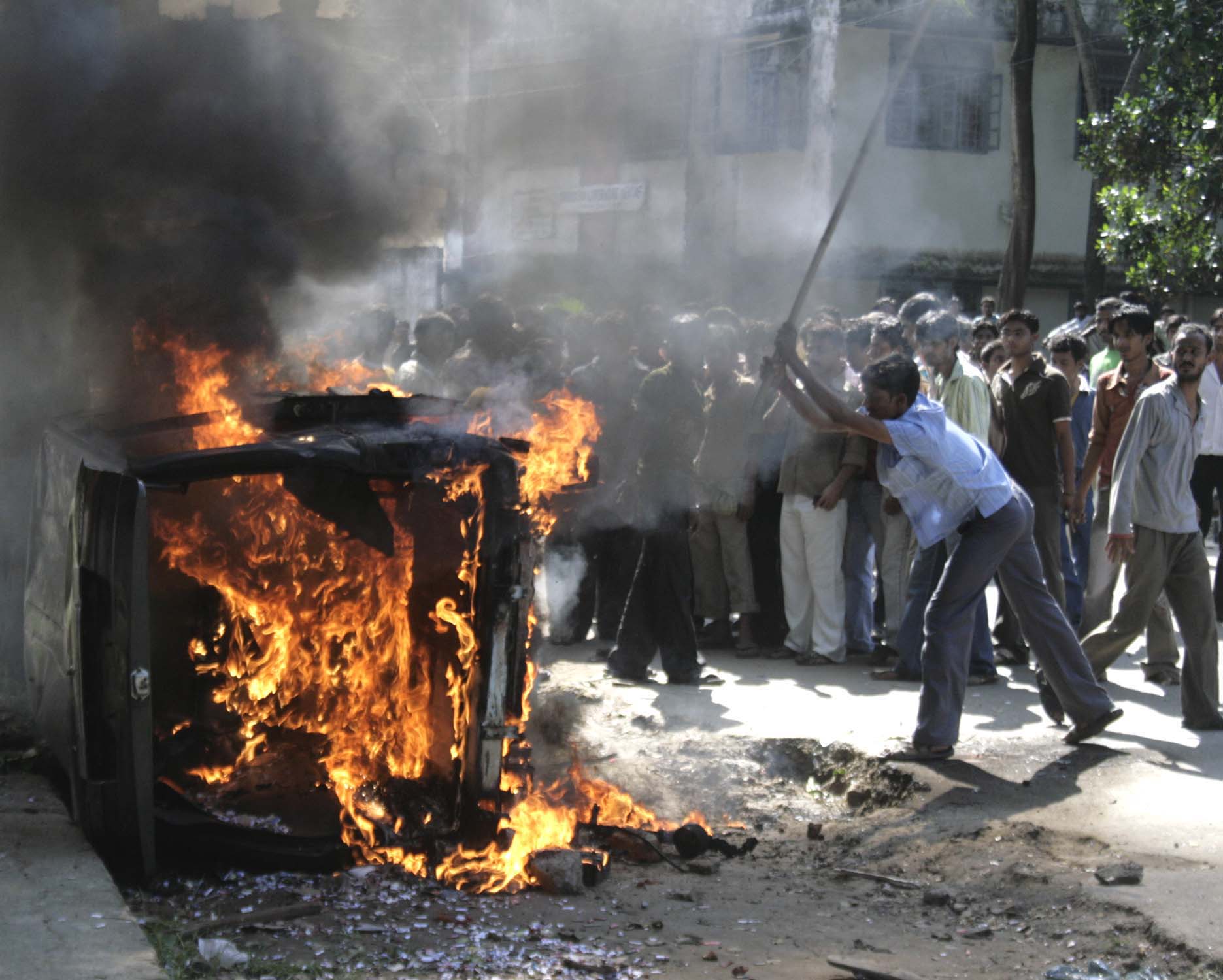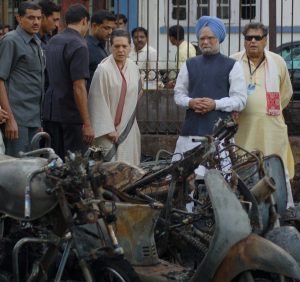On October 30, 2008, as many as 88 people were killed and more than 500 injured when serial blasts triggered by militants ripped through four districts in India’s border state of Assam. It remains the third biggest bomb attack ever in India, after the Mumbai blasts of 1993 and the train bombings in the same city in 2006.
Last month, a court in Assam upheld the life sentence of former chief of the National Democratic Front of Bodoland (NDFB-R) Ranjan Daimary for his role in the bombings. Four accomplices of Daimary were given jail terms between 5-7 years under the Unlawful Activities (Prevention) Act for involvement in the blasts.
Earlier, in January 2019, a special court in Guwahati sentenced Daimary and nine others to life imprisonment for murder and other charges. A year later, the former rebel chief was released on interim bail for four weeks to travel to Delhi and sign an agreement with the government.
Like some similar episodes in the past, there were many questions about the serial blasts that remained unanswered. Still, interviews of police and intelligence officers and former rebels from Assam who were based in Bangladesh for many years have helped to connect some dots on the blasts to give us a larger picture.
The Misleading Focus on Islamist Groups
Following the blasts, the case was probed by the Special Investigation Team (SIT) of the Assam Police before it was handed over to the Central Bureau of Investigation (CBI) after a couple of months.
R. Chandranathan, former inspector general in the Assam Police, who superannuated last year as the police chief of neighboring Meghalaya state, was tasked to head the SIT after the blasts. He told The Diplomat, “From the probe that the SIT had conducted before the case was handed over to the CBI, it was apparent that the blasts were triggered by the ISI (Inter-Services Intelligence, Pakistan’s intelligence agency). Secondly, there was a lot of planning ahead of the deadly operation which was executed meticulously by NDFB. And finally, there is indication about the involvement of another militant outfit indirectly in the blasts.”
Even before the SIT began its probe, the general assumption in the country was that the blasts were triggered by an Islamist terrorist outfit. A day after the bombings, an anonymous caller identifying himself as a functionary of an unknown outfit called Islamic Security Force – Indian Mujahideen claimed responsibility for the blast. The police were also examining the possibility of the bombings as a combined operation by the proscribed United Liberation Front of Asom (ULFA) and the Bangladesh-based Harkat ul Jihad-e-Islami (HuJI).
The SIT drew a blank in the investigation for two weeks. Another officer engaged with the squad claimed that there was “tremendous pressure” from the Assam Police’s Special Branch (SB) to compile a report identifying an Islamist outfit as the perpetrator of the crime.
“The reason behind SB’s insistence on Islamist outfits was not difficult to fathom. Some officers had siphoned a large amount of money from the ‘secret funds’ on the alibi of combating these groups that were supposed to have struck deep roots in Assam,” the officer said, on condition of anonymity. “Even a fictitious list of five Muslim functionaries believed to have been involved in the blasts was forwarded by the SB to the Intelligence Bureau (IB) and National Security Council.”
Incidentally, the Sashastra Seema Bal (SSB), a border force deployed along the India-Bhutan border, had alerted the Assam SB about the possibility of a terror strike by the NDFB about a month ahead of the blasts. A former officer who had served in the SB years ago claimed that some places identified in the alert as targets proved correct, but the branch ignored the warning at the time.
The SIT’s first breakthrough came with the arrest of Nilim Daimary along the India-Bangladesh border in Meghalaya state. He was brought to Assam on remand from Meghalaya but the SB originally gave him a clean chit after two days of interrogation. The story took a different turn when the SIT quizzed him and unearthed contact details of some NDFB leaders in Bangladesh from his cell phone.
From Daimary, the trail led to an NDFB functionary named Thungri Bodo, who was based in Kokrajhar and who the SIT believed had played a role in the bombings. Bodo sensed the danger and decided to cross the border to Bangladesh before he could be interrogated. He was shot there for unknown reasons.
Fortunately for the SIT, Bodo had left behind his cell phone, which was recovered from Kokrajhar in Assam. It yielded the numbers of other functionaries of the NDFB, who were traced and arrested within a couple of weeks.
Even as more details were being unraveled, the case was transferred to the Central Bureau of Investigation. Apparently, many high-ranking officials cutting across several ministries in New Delhi and Assam – including the state chief minister, Tarun Gogoi – did not believe that the NDFB could be involved in the blasts.
Rebel groups had never used such colossal quantities of explosives in the past. The intensity of the blasts can be gauged from the forensic investigations, which revealed that about 25-30 kilograms of RDX were used in every car bomb in Guwahati and combined with ammonium nitrate as the propellant.
Eventually, the CBI’s probe confirmed almost all the details on the blasts gathered earlier by the SIT. The bureau charged 22 people in the case; of those, seven (including Thungri Bodo) were declared absconders. NDFB chief Ranjan Daimary was handed over to India by Bangladesh in 2010 after being nabbed in Dhaka. He was supposedly tight-lipped about the sequence of events leading to the blasts or the reasons that prompted him to execute the operation.

A blast site in Assam’s capital Guwahati on Oct. 30, 2008. Photo by special arrangement.
Claims of ISI Involvement
Some explain the motives behind the attack by pointing to involvement by Pakistan’s intelligence agency – possibly unsanctioned involvements by “rogue” actors.
Chandranathan’s claim about the ISI’s involvement was corroborated by other intelligence officials, who pinned the blame on “rogue elements” in the ISI who were disenchanted with the appointment of Ahmad Shuja Pasha as the chief of the agency. The anti-Pasha clique was supposedly unhappy as well with the policies unveiled by Bangladesh’s army-backed regime against radical Islamist outfits and its growing bonhomie with New Delhi.
“Several operations were planned by a section in the ISI with the goal to discredit Pasha, out of which three were executed in a brief span of less than two months,” one official claimed. In addition to the attack in Assam, he was referring to the October 1 serial blasts in Agartala, Tripura, another state in India’s Northeast contiguous to Assam and bordering Bangladesh, and the Mumbai terror attacks on November 26, executed less than a month after the attack in Assam.
Incidentally, years later, Pasha was quoted in a book authored by a former director of the U.S. Central Intelligence Agency (CIA) as saying that some “retired members” of the ISI were engaged in training the terrorists for the Mumbai operation.
In Bangladesh, the preparation for the blasts apparently began almost four months in advance when the All Tripura Tiger Force (ATTF) and the NDFB were roped in by the ISI for the operations. Indian government officials said that several rounds of meetings were held between the ISI and the representatives of these rebel groups to finetune the plan of attack at different locations in India.
Officials believed that another rebel group from India’s Northeast that had a presence in Bangladesh played a role in assisting the ISI to select the ATTF and NDFB for the deadly operations.
Kuldeep Kumar was a senior police officer in Tripura during the serial blasts at Agartala that injured 76 people. In his book “Police and Counterinsurgency: The Untold Story Of Tripura’s COIN Campaign,” he wrote, “The State CID (Criminal Investigation Department) successfully cracked the case in less than 3 months with the arrest of many local ATTF militants and their accomplices and unearthed the role of other northeast militant outfits and some foreign agencies in this case.”
The ATTF was too weak and its area of influence in Tripura too limited to trigger the blasts at multiple locations. It might have been given weapons and funds as a quid pro quo for planting the bombs in Agartala. The ISI’s focus was on equipping the NDFB with the necessary logistics and support since the operation could have a greater impact in Assam due to its size and importance.
There are different theories explaining the decision by the NDFB’s Ranjan Daimary faction in Bangladesh to plant the bombs in Assam. Some government officials said that Daimary was “compelled” by the ISI and a pro-Pakistan coterie in the Directorate General of Forces Intelligence (Bangladesh’s external intelligence agency) to take part in the operation. It’s possible he was threatened with arrest and repatriation to India if he spurned the offer.
The second theory suggests that Daimary was upset with the NDFB’s Assam-based over-ground faction, headed by Govinda Basumatary, which had decided to engage in negotiations with the Indian government. Daimary supposedly wanted to deliver a stern message to the government that the peace process could not be initiated without his approval and participation.
Some former rebels from India’s Northeast, now based in Bangladesh, felt that a combination of several factors prompted the NDFB faction to take the plunge in the operation. One motive was the hope that the ISI’s assistance would contribute toward reviving the sagging fortunes of the outfit, which was already struggling for survival.
We may never know which of these theories is true. In 2016, I interviewed Ranjan Daimary at his residence in Assam’s Udalguri after he was granted bail by the court. Daimary narrated fascinating details about how weapons were procured in Bangladesh, the NDFB’s linkages with other rebel groups, and how camps were maintained in the country’s Chittagong Hill Tracts. But he kept mum on the serial blasts in Assam.

































